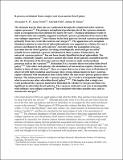R-process enrichment from a single event in an ancient dwarf galaxy
Author(s)
Simon, Joshua D.; Ji, Alexander Pung; Frebel, Anna L.; Chiti, Anirudh
DownloadR-process enrichment.pdf (3.765Mb)
OPEN_ACCESS_POLICY
Open Access Policy
Creative Commons Attribution-Noncommercial-Share Alike
Terms of use
Metadata
Show full item recordAbstract
Elements heavier than zinc are synthesized through the rapid (r) and slow (s) neutron-capture processes. The main site of production of the r-process elements (such as europium) has been debated for nearly 60 years. Initial studies of trends in chemical abundances in old Milky Way halo stars suggested that these elements are produced continually, in sites such as core-collapse supernovae. But evidence from the local Universe favours the idea that r-process production occurs mainly during rare events, such as neutron star mergers. The appearance of a plateau of europium abundance in some dwarf spheroidal galaxies has been suggested as evidence for rare r-process enrichment in the early Universe, but only under the assumption that no gas accretes into those dwarf galaxies; gas accretion8 favours continual r-process enrichment in these systems. Furthermore, the universal r-process pattern has not been cleanly identified in dwarf spheroidals. The smaller, chemically simpler, and more ancient ultrafaint dwarf galaxies assembled shortly after the first stars formed, and are ideal systems with which to study nucleosynthesis events such as the r-process. Reticulum II is one such galaxy. The abundances of non-neutron-capture elements in this galaxy (and others like it) are similar to those in other old stars. Here, we report that seven of the nine brightest stars in Reticulum II, observed with high-resolution spectroscopy, show strong enhancements in heavy neutron-capture elements, with abundances that follow the universal r-process pattern beyond barium. The enhancement seen in this ‘r-process galaxy’ is two to three orders of magnitude higher than that detected in any other ultrafaint dwarf galaxy. This implies that a single, rare event produced the r-process material in Reticulum II. The r-process yield and event rate are incompatible with the source being ordinary core-collapse supernovae, but consistent with other possible sources, such as neutron star mergers.
Date issued
2016-03Department
Massachusetts Institute of Technology. Department of PhysicsJournal
Nature
Publisher
Nature Publishing Group
Citation
Ji, Alexander P.; Frebel, Anna; Chiti, Anirudh and Simon, Joshua D. “R-Process Enrichment from a Single Event in an Ancient Dwarf Galaxy.” Nature 531, no. 7596 (March 21, 2016): 610–613. © 2016 Macmillan Publishers Limited, part of Springer Nature
Version: Author's final manuscript
ISSN
0028-0836
1476-4687